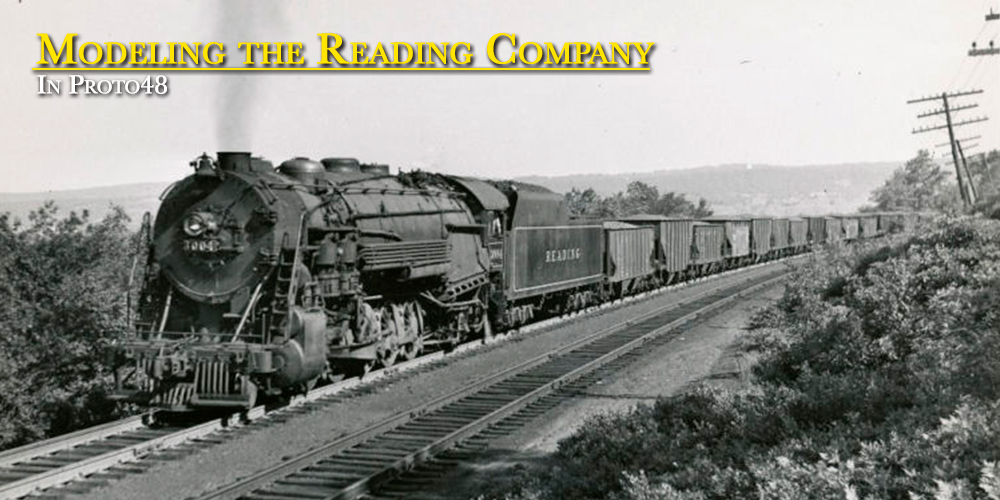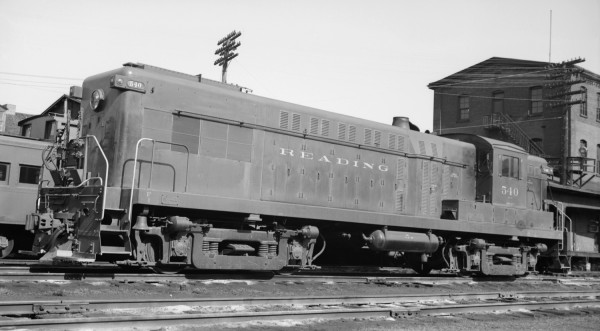
The Reading Company had been a long time buyer from Baldwin locomotive Works. They had bought steam locomotive from them and had been very happy with the diesel switchers made by Baldwin. When the railroad turn to the road switcher models they again turned to Baldwin and bought their AS-16 model.
There are good sources of information on these units in print. Here is a short list:
- Diesels of the Reading Company Volume 1, Paul K. Withers
- Reading Diesels Volume 1 The First Generation, Dale Woodland
- Diesel Era September/October 1991, Reading Baldwin AS-16 Road switchers, Gerald Bernet
While each group of AS-16’s were different they did have a few things in common. They all had walkways over the top of the vent in the roofs. Most had louvers on the engineer’s side of the long hood under the air intakes. They all had railroad applied rain gutters applied to the cab roofs.
All the AS-16’s were delivered in the Pullman Green paint scheme, and they wore it until they were retired. As delivered they had green handrails and low numbers on the ends of the locomotives. During sometime around 1953 the handrails were painted the safety yellow. Sometime near 1956 the end numbers started to move up on the end. I would imagine so that the tower operators could see the numbers.
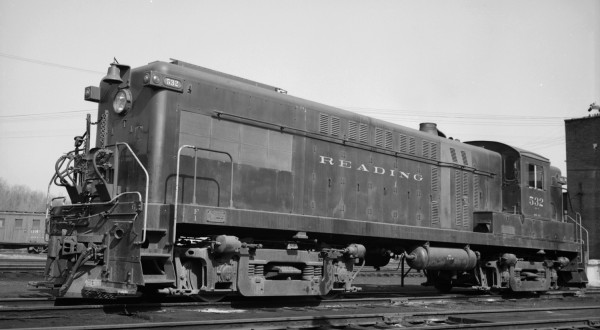
The first group #530-537 arrived on the property from 7/51-9/51. They were straight freight locomotives without dynamic brakes. They had 900 gallon fuel tanks above the frame directly behind the cabs, leaving the space between the trucks under the locomotive open. Their bell’s were mounted at the top of the long hoods. The long hoods were forward.
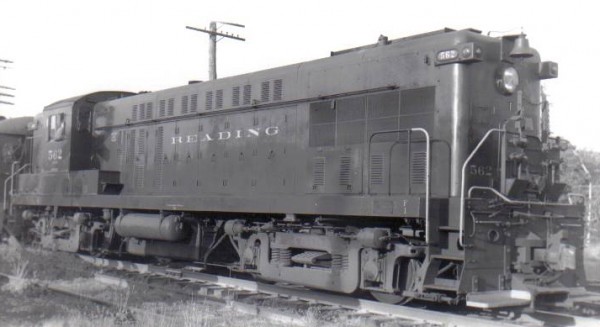
The next four locomotives to arrive were 560-563 were dual controlled, steam generator equipped passenger locomotives. They were based out of Green Street engine house. Their 1000 gallon fuel tank was under the frame between the trucks. The 900 gallon tank behind the cab was used for water for the steam generator. The bell was still mounted on the end of the locomotive.
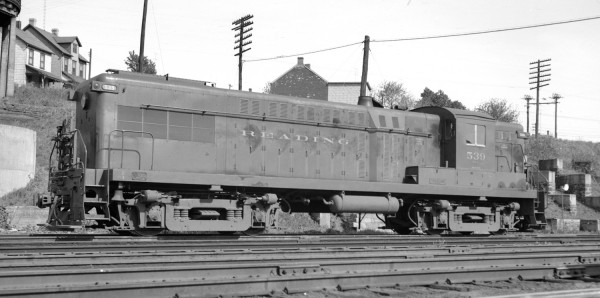
The next group of freight units #538-550 arrived 10/51-11/51. Externally they differed from the first group of freight units only in the moving of the bell from the end to under the frame on the fireman’s side of the front of the locomotive. Not visible to the modeler they were heavier than the first group by 1100 lbs.
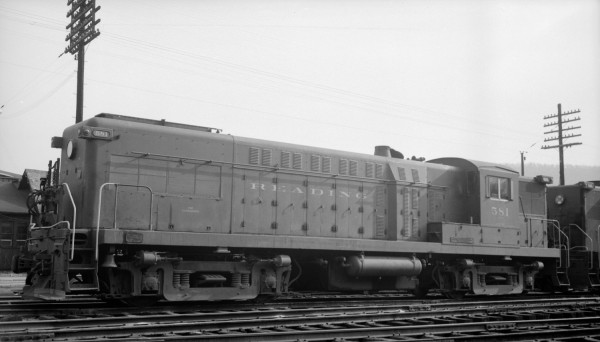
The next group of AS-16’s #576-589 arrived on the property between 6/52-7/52. They were equipped with dynamic brakes in the short hood, the bell mounted under the frame, had a 1000 gallon fuel tank under the frame between the trucks and did not have a tank of the short hood end of the locomotive. In addition they were 1300 lbs. heavier than the last group of freight locomotives.
The grill work in the short hood for the dynamic brake required the number boards be moved up the car side to the top of the short hood.
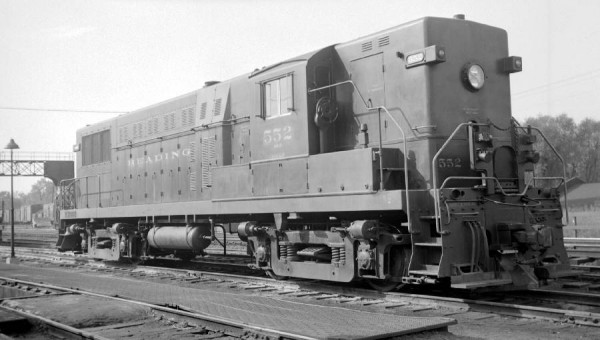
The last group of Baldwins #551-554 arrived 10/53. The order started out a 10 units but the railroad cut the order to just four units. The six locomotives left over at Baldwin were later sold to the PRSL without the Dynamic brake equipment. This was also the first use of Baldwin’s new carbody design which had enough room to move the dynamic brake equipment into the long hood. This order went back to the use of the 900 gallon fuel tank behind the cab. leaving the space under the long hood between the trucks open.
One of the problems the railroad had with the Baldwins was that they could not MU with other locomotives. Worse than that, they could not even MU with each different order. The 1951 locomotives could not MU with the 1952 units until the railroad made modifications to the load regulators, costing the railroad $16,820 per unit for the modifications. This could also account for why early photos of the Baldwins show them MU’ing with other units from the same orders. The 1953 locomotives never were able to MU with the rest of the Baldwin fleet. They had electric throttles which aloud them to MU with other manufactures locomotives but not the other Baldwins.
Most of the photos that have been published have been of the units later in life. This is understandable as they replaced steam locomotives as they arrived and most railfans tried to capture what was going away instead of what was replacing it. Why not, the new units would be around for another 15 years? What few photos are around of the units in their first years show that changes came to them early. I’ve already pointed out the numbers on the ends move higher. The hand rails get painted with safety colors and also they added louvers under the long hood’s air intake on the engineer’s side of the locomotive. This appears to have happened in late 1952 or early 1953, after my modeling period of the Summer of 1952.
Below is a chart of the Baldwin AS-16 roster on the Reading. Some of the data is pulled from the Diesel Era article on the Reading AS-16’s and some from photos. Assignment refers to engine house assignments painted on the locomotive as seen is photos of the units.
| No. | Built | DB | Bell | Fuel Tank | Assignment |
| 530 | 7-51 | – | Top | Walkway | StC |
| 531 | 8-51 | – | Top | Walkway | SH |
| 532 | 8-51 | – | Top | Walkway | G |
| 533 | 8-51 | – | Top | Walkway | CATA |
| 534 | 9-51 | – | Top | Walkway | G |
| 535 | 9-51 | – | Top | Walkway | |
| 536 | 9-51 | – | Top | Walkway | SH |
| 537 | 9-51 | – | Top | Walkway | G |
| 538 | 10-51 | – | UF | Walkway | G |
| 539 | 10-51 | – | UF | Walkway | |
| 540 | 11-51 | – | UF | Walkway | R |
| 541 | 11-51 | – | UF | Walkway | |
| 542 | 11-51 | – | UF | Walkway | StC |
| 543 | 11-51 | – | UF | Walkway | G |
| 544 | 11-51 | – | UF | Walkway | SH |
| 545 | 11-51 | – | UF | Walkway | |
| 546 | 11-51 | – | UF | Walkway | StC |
| 547 | 11-51 | – | UF | Walkway | |
| 548 | 11-51 | – | UF | Walkway | |
| 549 | 11-51 | – | UF | Walkway | |
| 550 | 11-51 | – | UF | Walkway | StC |
| 551 | 10-53 | LH | UF | Walkway | |
| 552 | 10-53 | LH | UF | Walkway | |
| 553 | 10-53 | LH | UF | Walkway | |
| 554 | 10-53 | LH | UF | Walkway | |
| 560 | 9-51 | – | Top | UF | GS |
| 561 | 9-51 | – | Top | UF | GS |
| 562 | 9-51 | – | Top | UF | GS |
| 563 | 9-51 | – | Top | UF | GS |
| 576 | 6-52 | SH | UF | UF | |
| 577 | 6-52 | SH | UF | UF | |
| 578 | 6-52 | SH | UF | UF | |
| 579 | 6-52 | SH | UF | UF | StC |
| 580 | 6-52 | SH | UF | UF | |
| 581 | 6-52 | SH | UF | UF | StC |
| 582 | 7-52 | SH | UF | UF | |
| 583 | 7-52 | SH | UF | UF | StC |
| 584 | 7-52 | SH | UF | UF | |
| 585 | 7-52 | SH | UF | UF | StC |
| 586 | 7-52 | SH | UF | UF | StC |
| 587 | 7-52 | SH | UF | UF | StC |
| 588 | 7-52 | SH | UF | UF | |
| 589 | 7-52 | SH | UF | UF | StC |
References:
- Diesels of the Reading Company Volume 1, Paul K. Withers
- Diesel Era – 1991 September/October – Reading Baldwin AS-16 Road Switchers by Gerard E. Bernet.
- Diesel Era – 1998 March/April – Reading’s First-Generation Diesels by by Paul K. Withers
- Reading Diesels Volume 1 The First Generation – by Dale Woodland
- Photograph’s from George Losse Collection either scanned from negatives or prints.
